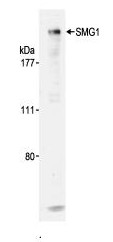DR1035 Sigma-AldrichAnti-SMG1 Rabbit pAb
This Anti-SMG1 Rabbit pAb is validated for use in Immunoblotting for the detection of SMG1.
More>> This Anti-SMG1 Rabbit pAb is validated for use in Immunoblotting for the detection of SMG1. Less<<Synonyms: Anti-ATM-Related Kinase, Anti-LIP, Anti-61E3.4, Anti-KIAA0421, Anti-ATX, Anti-PI-3-Kinase-Related Kinase SMG1
Recommended Products
Overview
| Replacement Information |
|---|
Key Spec Table
| Species Reactivity | Host | Antibody Type |
|---|---|---|
| H | Rb | Polyclonal Antibody |
| References | |
|---|---|
| References | Abraham, R.T., 2004. DNA Repair (Amst.) 3, 919. Brumbaugh, K.M., et al. 2004. Mol. Cell. 14, 585. Yamashita, A., et al. 2001. Genes Dev. 15, 2215. |
| Product Information | |
|---|---|
| Form | Liquid |
| Formulation | In 100 mM NaCl, 10 mM phosphate, pH 7.2. |
| Positive control | HeLa cells |
| Preservative | ≤0.1% sodium azide |
| Quality Level | MQ100 |
| Applications | |
|---|---|
| Key Applications | Immunoblotting (Western Blotting) |
| Application Notes | Immunoblotting (0.1 µg/ml) |
| Application Comments | Antibody should be titrated for optimal results in individual systems. |
| Physicochemical Information |
|---|
| Dimensions |
|---|
| Materials Information |
|---|
| Toxicological Information |
|---|
| Safety Information according to GHS |
|---|
| Safety Information |
|---|
| Product Usage Statements |
|---|
| Packaging Information |
|---|
| Transport Information |
|---|
| Supplemental Information |
|---|
| Specifications |
|---|
| Global Trade Item Number | |
|---|---|
| Catalogue Number | GTIN |
| DR1035 | 0 |
Documentation
Anti-SMG1 Rabbit pAb SDS
| Title |
|---|
Anti-SMG1 Rabbit pAb Certificates of Analysis
| Title | Lot Number |
|---|---|
| DR1035 |
References
| Reference overview |
|---|
| Abraham, R.T., 2004. DNA Repair (Amst.) 3, 919. Brumbaugh, K.M., et al. 2004. Mol. Cell. 14, 585. Yamashita, A., et al. 2001. Genes Dev. 15, 2215. |








